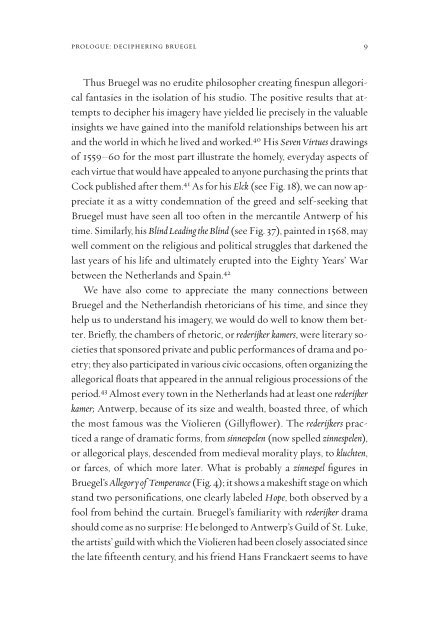Pieter Bruegel and the Art of Laughter - AAAARG.ORG
Pieter Bruegel and the Art of Laughter - AAAARG.ORG
Pieter Bruegel and the Art of Laughter - AAAARG.ORG
Create successful ePaper yourself
Turn your PDF publications into a flip-book with our unique Google optimized e-Paper software.
prologue: deciphering bruegel 9<br />
Thus <strong>Bruegel</strong> was no erudite philosopher creating finespun allegorical<br />
fantasies in <strong>the</strong> isolation <strong>of</strong> his studio. The positive results that attempts<br />
to decipher his imagery have yielded lie precisely in <strong>the</strong> valuable<br />
insights we have gained into <strong>the</strong> manifold relationships between his art<br />
<strong>and</strong> <strong>the</strong> world in which he lived <strong>and</strong> worked. 40 His Seven Virtues drawings<br />
<strong>of</strong> 1559–60 for <strong>the</strong> most part illustrate <strong>the</strong> homely, everyday aspects <strong>of</strong><br />
each virtue that would have appealed to anyone purchasing <strong>the</strong> prints that<br />
Cock published after <strong>the</strong>m. 41 As for his Elck (see Fig. 18), we can now appreciate<br />
it as a witty condemnation <strong>of</strong> <strong>the</strong> greed <strong>and</strong> self-seeking that<br />
<strong>Bruegel</strong> must have seen all too <strong>of</strong>ten in <strong>the</strong> mercantile Antwerp <strong>of</strong> his<br />
time. Similarly, his Blind Leading <strong>the</strong> Blind (see Fig. 37), painted in 1568, may<br />
well comment on <strong>the</strong> religious <strong>and</strong> political struggles that darkened <strong>the</strong><br />
last years <strong>of</strong> his life <strong>and</strong> ultimately erupted into <strong>the</strong> Eighty Years’ War<br />
between <strong>the</strong> Ne<strong>the</strong>rl<strong>and</strong>s <strong>and</strong> Spain. 42<br />
We have also come to appreciate <strong>the</strong> many connections between<br />
<strong>Bruegel</strong> <strong>and</strong> <strong>the</strong> Ne<strong>the</strong>rl<strong>and</strong>ish rhetoricians <strong>of</strong> his time, <strong>and</strong> since <strong>the</strong>y<br />
help us to underst<strong>and</strong> his imagery, we would do well to know <strong>the</strong>m better.<br />
Briefly, <strong>the</strong> chambers <strong>of</strong> rhetoric, or rederijker kamers, were literary societies<br />
that sponsored private <strong>and</strong> public performances <strong>of</strong> drama <strong>and</strong> poetry;<br />
<strong>the</strong>y also participated in various civic occasions, <strong>of</strong>ten organizing <strong>the</strong><br />
allegorical floats that appeared in <strong>the</strong> annual religious processions <strong>of</strong> <strong>the</strong><br />
period. 43 Almost every town in <strong>the</strong> Ne<strong>the</strong>rl<strong>and</strong>s had at least one rederijker<br />
kamer; Antwerp, because <strong>of</strong> its size <strong>and</strong> wealth, boasted three, <strong>of</strong> which<br />
<strong>the</strong> most famous was <strong>the</strong> Violieren (Gillyflower). The rederijkers practiced<br />
a range <strong>of</strong> dramatic forms, from sinnespelen (now spelled zinnespelen),<br />
or allegorical plays, descended from medieval morality plays, to kluchten,<br />
or farces, <strong>of</strong> which more later. What is probably a zinnespel figures in<br />
<strong>Bruegel</strong>’s Allegory <strong>of</strong> Temperance (Fig. 4); it shows a makeshift stage on which<br />
st<strong>and</strong> two personifications, one clearly labeled Hope, both observed by a<br />
fool from behind <strong>the</strong> curtain. <strong>Bruegel</strong>’s familiarity with rederijker drama<br />
should come as no surprise: He belonged to Antwerp’s Guild <strong>of</strong> St. Luke,<br />
<strong>the</strong> artists’ guild with which <strong>the</strong> Violieren had been closely associated since<br />
<strong>the</strong> late fifteenth century, <strong>and</strong> his friend Hans Franckaert seems to have












